Information
China's major archaeological discoveries in 2016
The year 2016 is coming to an end, and this year witnessed several major archaeological discoveries that impressed us. We have selected the 10 most important archaeological discoveries for you. The official list of "China's top 10 archaeological finds of 2016" will be announced several months into 2017, so please see then how many lucky guesses we made.
Here are the China's top 10 archaeological discoveries in 2016, based on news coverage:
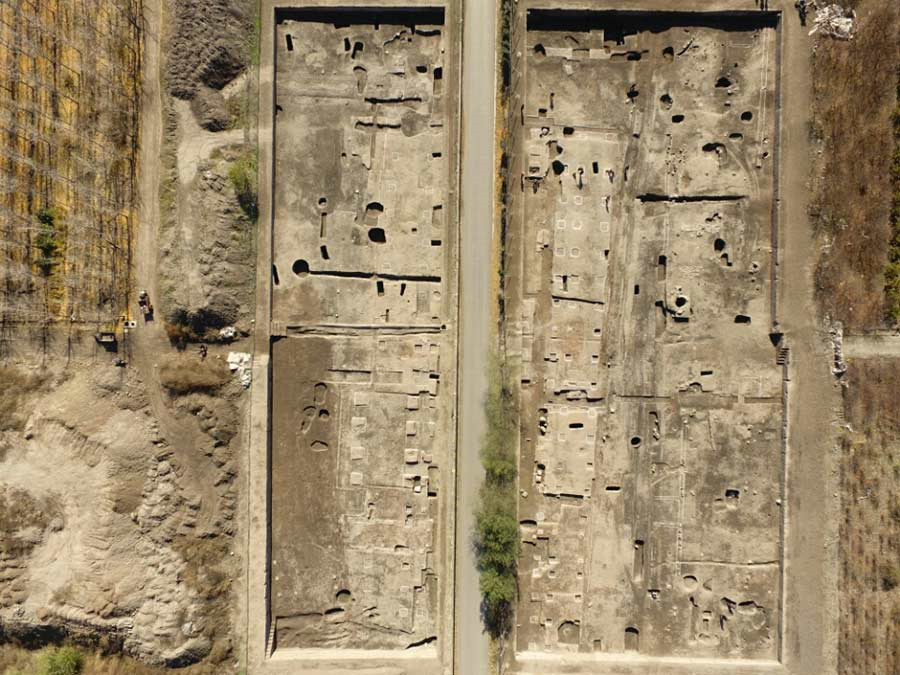 |
An aerial photograph offers a bird's eye view of the No. 2 architectural complex ruin in Jinyang ancient city, Shanxiprovince. [Photo by Zheng Yuan/For China Daily] |
Jinyang Palace of the Sui Dynasty found in Shanxi
Archaeologists working at Jinyang ancient city in Shanxi province believe they've found the site of the Jinyang Palace, which dates from the Sui Dynasty (581-618).
The identification is a major breakthrough, made after over 20 experts from the Chinese Academy of Social Sciences and National Museum of China investigated the No. 2 architectural complex ruin in Jinyang ancient city and its unearthed relics.
The ruin was initially identified as a large base from the late Tang period (618-907). Materials found from dilapidated stone tablets convinced the experts that the site was formerly the location of the Jinyang Palace.
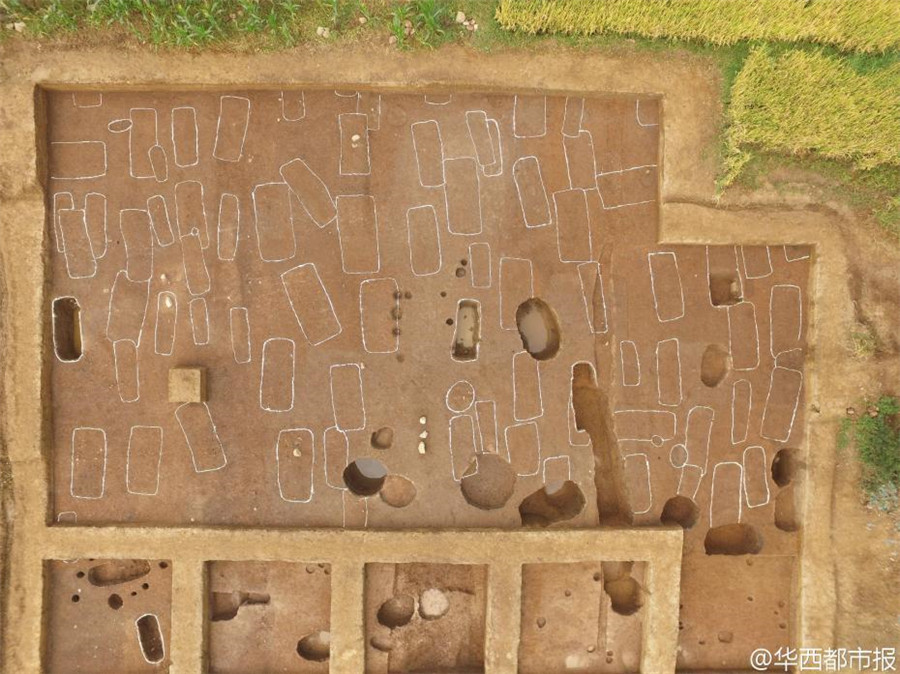 |
Human settlement sites from the pre-Qin period are discovered along the Anning river valley plain in Southwest China's Sichuan province. [File photo/Western China Metropolis Daily Micro-Blog] |
Pre-Qin period settlement sites discovered in SW China's Sichuan
Archaeologists have discovered more than 3,500 ancient post holes on the Anning River Plain in Sichuan province. The holes were made to hold posts for the construction of shelters more than 1,800 years before the establishment of the Qin Dynasty (221-206 BC), China's first feudal dynasty.
Nearly 50 square pits dating back to the pre-Qin period were found, with the length of their sides ranging from 2.8 to 3.5 meters, and depths ranging from 0.15 to 0.6 meters. These could be the remains of semi-crypt types of residences.
Graveyards covering more than 2,000 square meters also were discovered in the excavation. Most of the tombs were made of vertical pits, urns and stones.
Archaeologists hailed the findings on the Anning River Plain in Liangshan and neighboring Panzhihua as the second-largest number of pre-Qin human settlements ever found in Sichuan, behind only those on the Chengdu Plain.
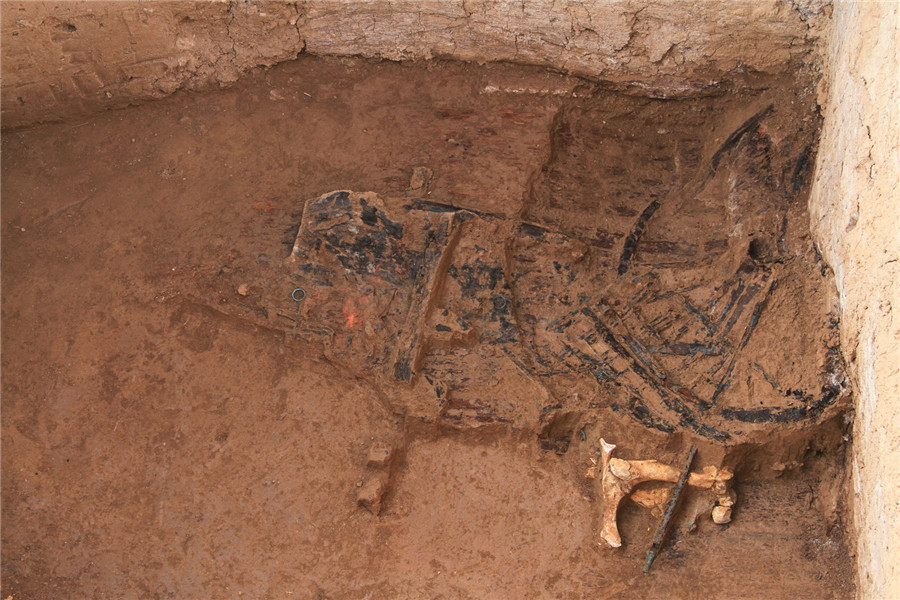 |
A wooden vehicle unearthed from an ancient sacrificial site in Fengxiang, Shaanxi province. [Photo provided to China Daily] |
Ancient State-level sacrificial site discovered
Archaeologists recently found a State-level venue used by ancient emperors to partake in sacrificial offerings.
Shaanxi Provincial Institute of Archaeology said that the finding had great academic value for in-depth research on social institutions and politics of the Qin (221-206 BC) and Western Han (206 BC-AD 24) dynasties, as well as ancient Chinese ritual culture.
The ancient sacrificial site, named Yongshan Blood Pool, is located in Fengxiang, about 15 kilometers southeast of the Yongcheng ruins, which is believed to have been the capital of the state of Qin (770-221 BC).
At the sites, archaeologists found 2,109 relics, mainly jade articles, and bronze chariots and horses, which were often used for sacrificial offerings in ancient times.
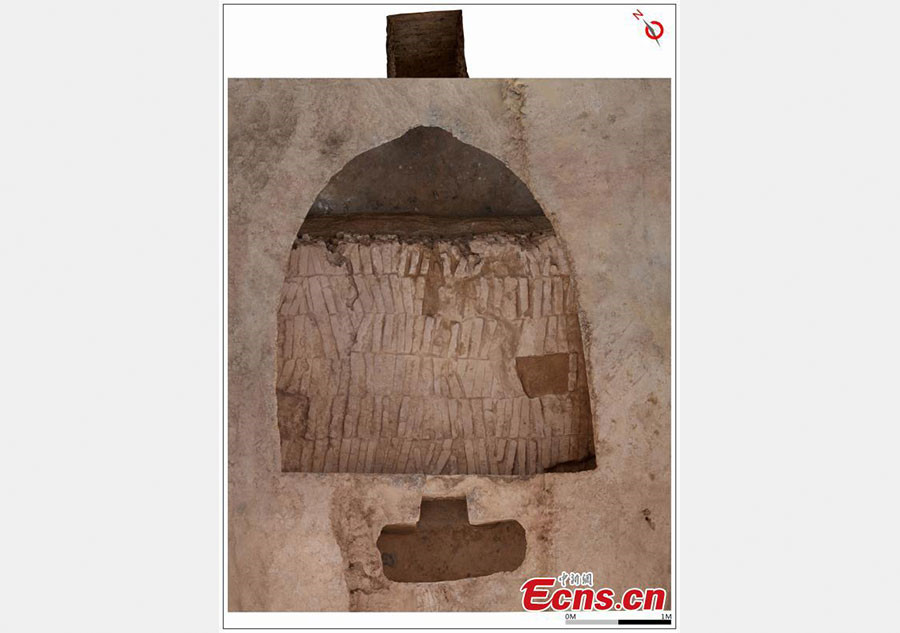 |
The kiln furnaces were found at the Sangyuan archaeological site in Fuping county, Northwest China's Shaanxi province. Bricks with handprints were also unearthed at the site, the largest Tang Dynasty (618-907) kiln factory ever found. [Photo provided by Shaanxi Provincial Institute of Archaeology] |
Largest Tang Dynasty kiln factory discovered in Shaanxi
More than 500 kiln furnaces, to-date the largest Tang Dynasty (618-907 AD) kiln factory ruins, were discovered lately in Fuping county, Northwest China's Shaanxi province.
Exquisite architectural components with quality craftsmanship, like bricks with patterns of animal faces, were unearthed at the kiln factory site.
Experts said that the kiln factory might be closely related to the construction of Tang Emperor Zhongzong's Dingling Mausoleum, and may have supplied building materials to meet other city construction demands of the era as well.
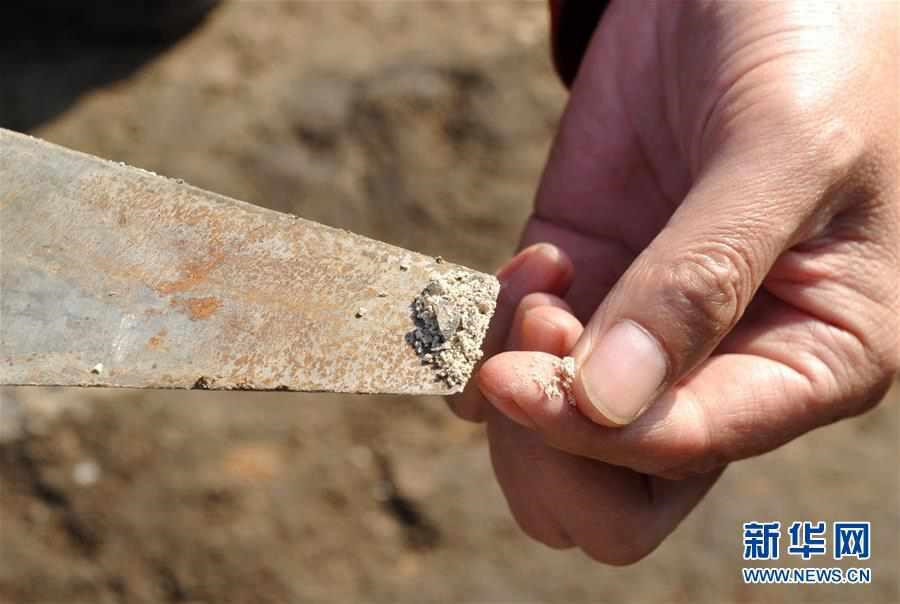 |
Archaeologists are conducting excavations of several salt-boiling sites constructed during the Tang Dynasty (618—907) in Huanghua, Hebei province. The majority of the sites are intact, although some are damaged. The diameters of the sites range from 1 to 6 meters. There are also a number of ash ditches and holes around the salt-boiling areas. [Photo/Xinhua] |
Ancient salt-boiling sites excavated in Hebei
The ruins, which were built sometime during the Tang Dynasty (618 -907), were found in Huanghua, a county-level city bordering the Bohai Sea.
The site is 2.5 kilometers from the ruins of Haifeng town, a protected heritage site thought to be the northern tip of the ancient Maritime Silk Road trade route.
During the excavation, archaeologists found round and oval burning sites with identifiable plant ash and red clay, which are presumed to be stoves used to extract salt.
Archaeologists said that judging from the unearthed pieces of porcelain and brick, the ruins could date back to as far as the Tang Dyansty.
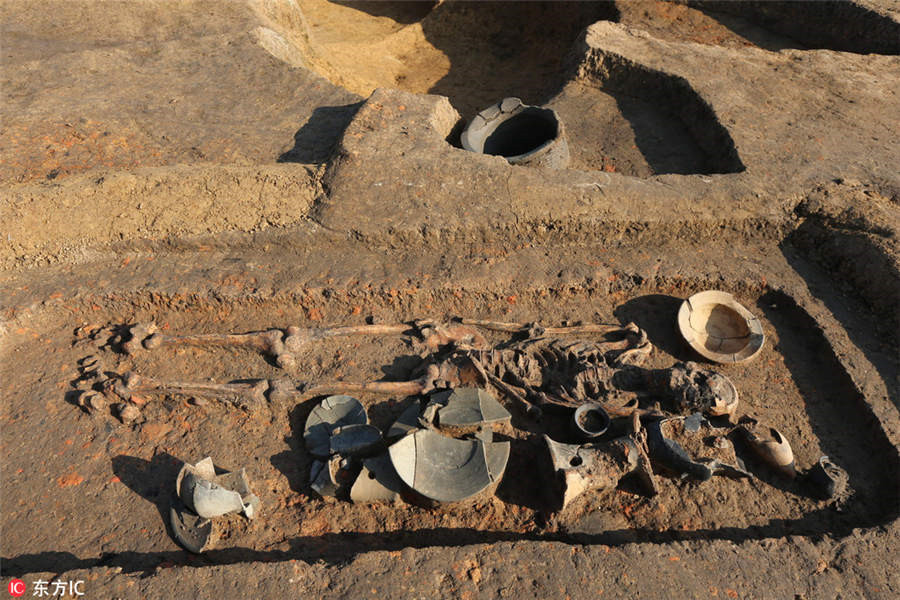 |
Bones and funeral objects are unearthed from the cultural site at Zhao village, Meihua town, Sihong county, Suqian city, Jiangsu province. [Photo/IC] |
Prehistoric relics of Dawenkou Culture unearthed from Jiangsu tombs
An ancient cultural site dating back more than 5,000 years was found by experts from the Nanjing Museum following a three month excavation at the Zhao village archaeological site in Suqian city in Jiangsu province.
The unearthed remains, from the late period of Dawenkou Culture (4100-2600 BC), have proved again the evolution of the early civilization in Jiangsu province.
Experts from the Nanjing Museum revealed that so far 18 tombs have been discovered and abundant funeral objects also were unearthed. The unearthed objects help the experts learn more about the funeral customs and living habits of people during that period, providing a more sufficient physical basis for the study of prehistoric society in Jiangsu province.
The Dawenkou Culture, first named after remains in Tai'an city of Shandong province, was distributed in Shandong, north of Jiangsu and southeast of Henan and the Liaodong Peninsula.
 |
Staff excavate the Luhun Rong tomb in Yichuan county, Luoyang city, Henan province, Jan 23, 2016.[Photo/Xinhua] |
Ancient Luhun Rong nobles' tomb excavated in Luoyang city
The tomb, found among mass graves in the Xu Yang cemetery, was believed to be the Luhun Rong nobles' tomb dating to 2,600 years ago. The Luhun Rong was an ethnic group that inhabited Central China during the Spring and Autumn Period (770-476 BC).
Experts have so far unearthed more than 50 relics from the site, including bronze instruments, ritual vessels, jade items and crystal.
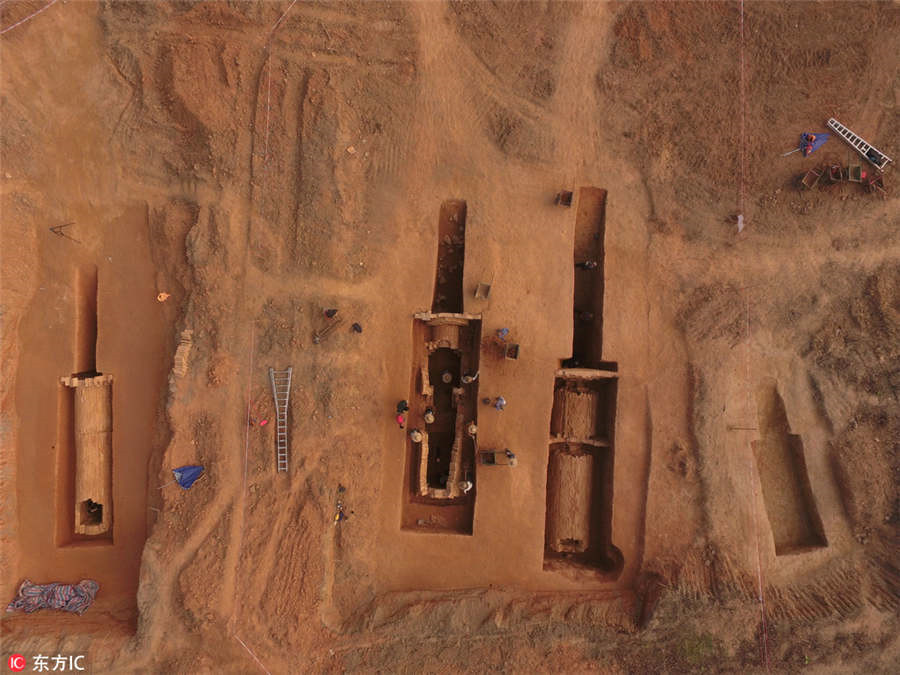 |
Twenty-five tombs spanning from the Shang Dynasty to the Ming Dynasty were found during an excavation at Xintang county in Guangzhou, Guangdong province. [Photo/IC] |
25 tombs spanning Shang and Ming dynasties unearthed in Guangzhou
Twenty-five tombs spanning from the Shang Dynasty (1600-1046 BC) to the Ming Dynasty (1368-1644) were found during an excavation at Xintang county in Guangzhou of South China's Guangdong province.
The findings included three tombs from the Shang Dynasty, one pit tomb from the late Western Han Dynasty (206 BC - 24 AD), 19 brick-chambered tombs from the Jin (265-420) and Southern Dynasties (420-589), one pit tomb from the Tang Dynasty (618-907) and one tomb from the Ming Dynasty.
The archaeological site is located at Longjingshan and Zongzaigang, which is in the Zengcheng Economic and Technological Development District's Xintang county, and 36 kilometers from urban Guangzhou. A total area of 66,000 square meters was under excavation.
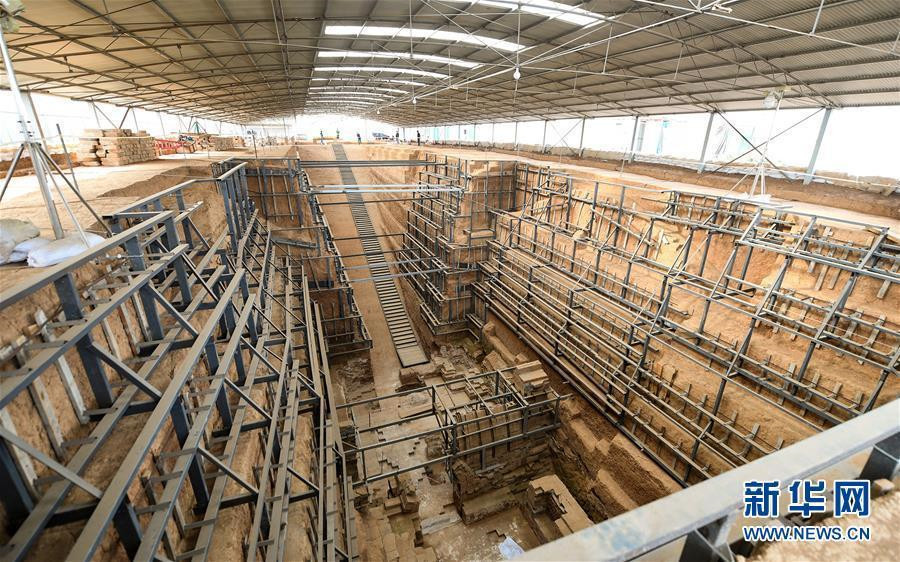 |
A view of the large-scale ancient tomb discovered in Xizhu village in Luoyang city, Central China's Henan province, Nov 10, 2016. [Photo/Xinhua] |
Large-scale ancient tomb from Three Kingdoms Period excavated in Henan
The excavation of a large-scale ancient tomb from the period of Three Kingdoms (AD 220-280) has come to an end in Xizhu village in Luoyang city, Central China's Henan province, Nov 10, 2016.
The tomb is about 52 meters in length and 12 meters in depth. More than 400 objects of pottery, ironware, bronze ware, lacquer ware, and jade articles have been unearthed.
Based on objects discovered, archaeologists deduced that the tomb must belong to someone in Cao Wei's regime during the period of the Three Kingdoms but the identity of the owner is still unclear.
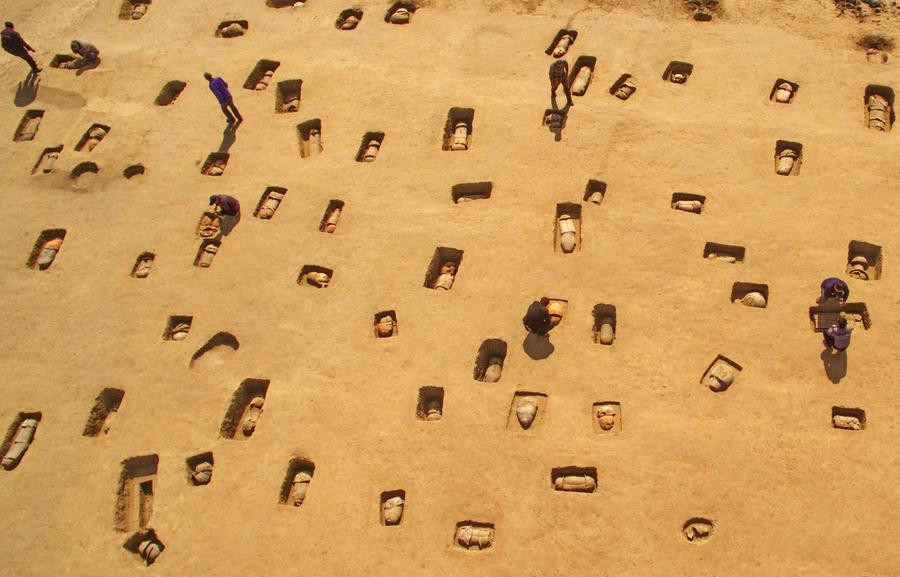 |
Archaeologists work at the ancient tomb site in Huanghua city, North China's Hebei province, Oct 10, 2016. [Photo/Xinhua] |
Ancient group tombs from Warring States Period discovered in Hebei
A total of 113 tombs, estimated to be more than 2,000 years old, have been discovered in Huanghua city, North China's Hebei province, which was thought to be the site of an ancient city called Fudi.
Human remains have been found and were buried using a method called 'urn burial', which means the corpses were wrapped using two to three large clay containers, such as urns, pots and bowls.
A small hole would be drilled at a side of the clay coating. It's believed that this was to let the soul of the deceased come and go freely.
Utensils made from pottery were also found and dated to around the Warring States (475 BC-221 BC) period.
Bai Yunxiang, vice head of the Institute of Archaeology under the Chinese Academy of Social Sciences, said the discovery will inform research into burial customs and city planning in ancient times.
Category: English
News
Information
Key words:
